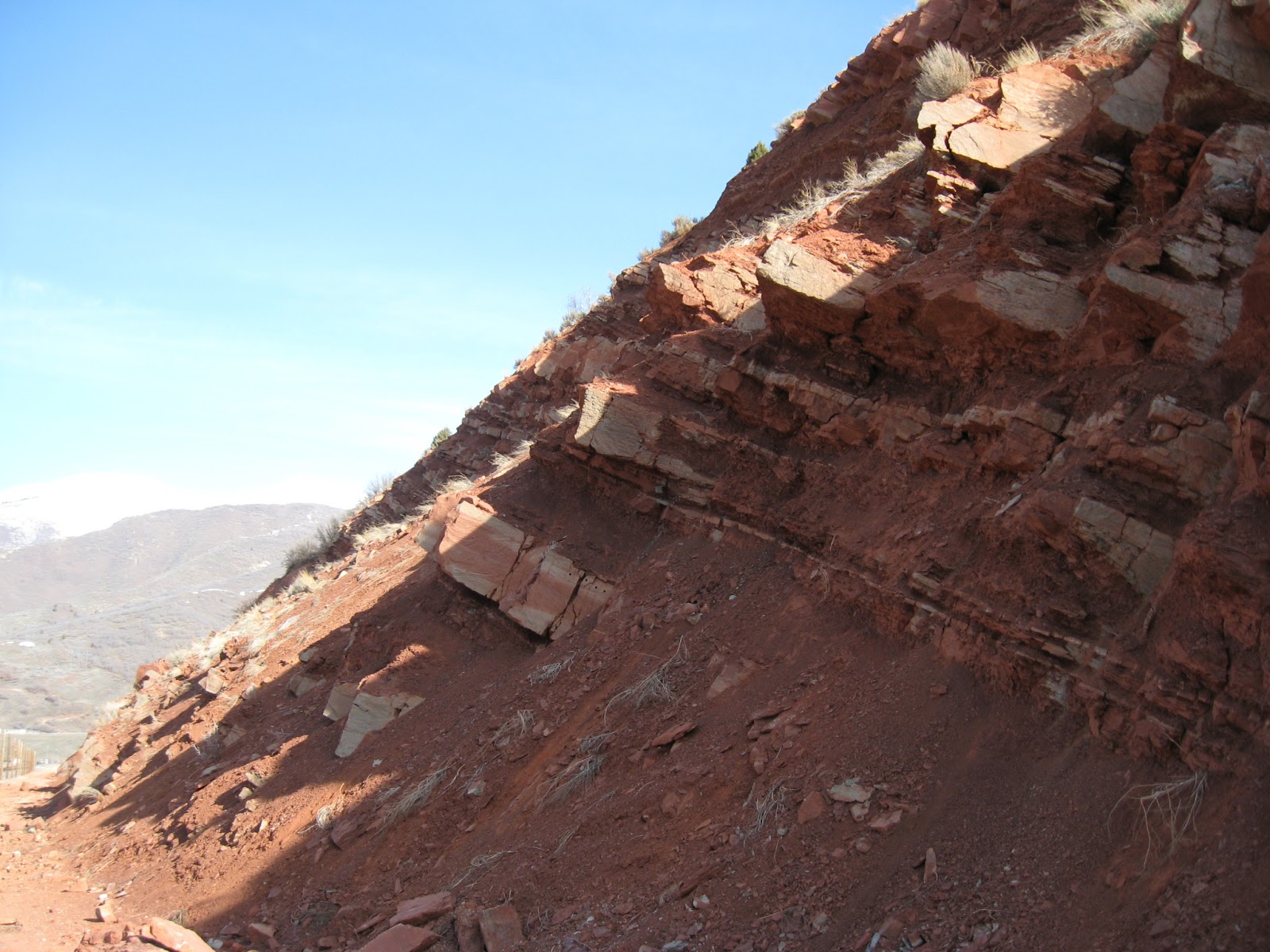But I won't dwell on St. Patrick's Day, since I'm Facebook fasting today, and most of my pageviews come from Facebook, so St. Patrick's Day will be over before most of you read this.
Yesterday I had a field trip for my Historical Geology class. It was nowhere near as fun as Death Valley, but it was still pretty fun.
We went up to Spanish Fork Canyon. At the mouth of the canyon are some windmills, which you can see from BYU on a clear day. We got out in the cold, 7:30 a.m. wind and talked about faults and Lake Bonneville. After we left, I noticed some faceted spurs, which are triangular landforms that form at faults. I was disappointed I didn't see them sooner, but I asked Dr. Britt at the next location if that's what they were, and he confirmed it. I was glad that I was able to recognize the landform without being told what it was. I mean, I had some clues, since we had been talking about faulting in the area, and I knew there were faceted spurs elsewhere near Spanish Fork, but I was still glad I recognized it.
Then we went to some places I had been for my Dinosaurs! class almost three years ago. (I'm getting old.) I'm not sure if this location had limestone or siltstone or something else. There were a bunch of Triassic bivalve shell fossils there; I gathered a mediocre one. (I got one last time I was there). Then we went down the road to a Triassic floodplain. This place mostly had trace fossils in shales. I don't really like walking on shale; you sink and it gets in your shoes. Plus, the trace fossils weren't that interesting, although someone found some small footprints, which were pretty cool.
We went to another location of the same formation, the Ankareh Formation. There were lots of rocks in the road there; I'm glad I wasn't driving. This place has a lot of sandstones mixed with siltstones and things; it has been upturned.
My favorite part about this place is the phytosaur tracks. You can see them in the bottom of this sandstone: The phytosaur made a mark in a stream, and then sandstone came and filled the tracks in. Sandstone doesn't erode easily, so the silty rock eroded and the sandstone stayed in place, preserving the mold of the tracks. Phytosaurs were ancient Triassic reptiles that looked like crocodilians, but they weren't. If you look closely, you can see the tracks in this picture.
Then we went to this place. If I recall correctly, this was Jurassic sandstone that was upturned, and then this valley was filled in with sediments.
Then we went to a place of lots of limestone. This was probably my favorite part of the trip. We climbed this mountain searching for fossils. Fossils were a little harder to find, but I did find a few. The only one I kept is a rock full of fossils. At first I thought it was an ordinary conglomerate rock. But then I looked closer, and I noticed not only bivalve shells (like clams) but gastropods as well (fancy snails). It was really fun to walk around on the steep slopes, the warm March sun shining on us, smelling sulfur from the small pond at the bottom of the mountain. Our professor always says, "It's a great day to be a geologist." And that's what I was thinking. Except that I'm not a geologist.
Then we saw some conglomerates from alluvial deposits. Then we visited a tufa formation. I had never heard of tufa before. It's a porous limestone that forms from springs and I think around plant roots. I found a leaf fossil, but I didn't keep it. I didn't like this place. It was the most slippery, and the rocks were the sharpest, and the rocks were loose, so I kept worrying about sending rocks falling down the mountain on top of people. Plus, we had to climb through a barbed wire fence. The opening was plenty big enough (it had been cut), but it was still a little disconcerting to go through, especially since we were walking on slippery rocks.
When I learned about tuff, the rock formed from volcanic materials, I wondered if the word tuff was related to the word tough, since rocks are tough. So I looked in the Oxford English Dictionary and discovered that the words aren't related; tough is Germanic and tuff is Latinate, from the Italian word tufa. So, having just learned about the rock called tufa, I looked up its etymology, and I found out that tuff and tufa have the same etymology, even though they are quite different rocks. (How nerdy can you get?)
The rest of the trip was less interesting. Our last stop was a coal seam. It seems that you only hear about coal in geology and at Christmas: Santa gives coal to naughty kids, Frosty's eyes were made of coal, and Bob Cratchit asked Ebenezer Scrooge if he could burn more coal for heat.
Field trips alone make geology classes worth it.



No comments:
Post a Comment